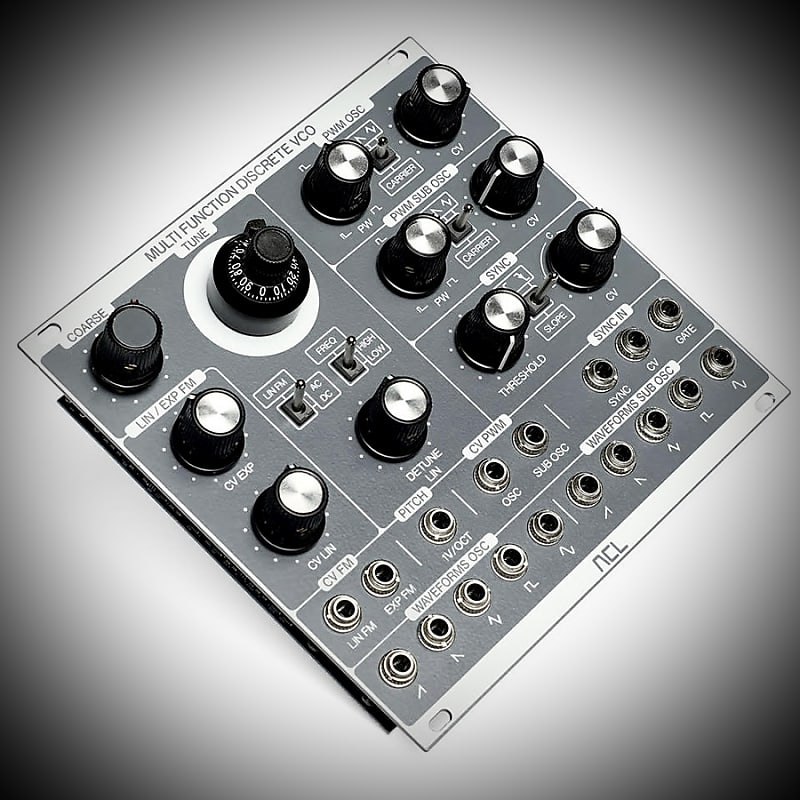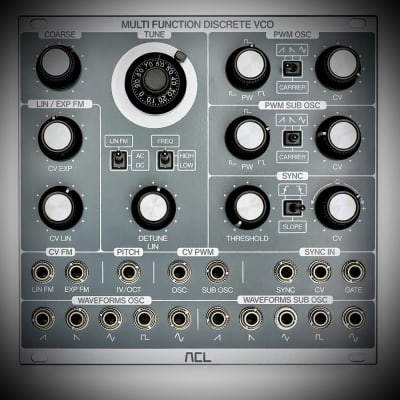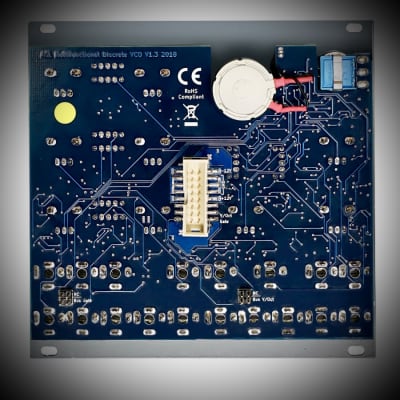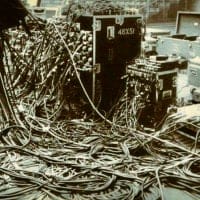New-in-box.
This thing is a beast. Brutal. Massive, phat! vintage analog sounds. One of the best-kept secrets in the Eurorack format analog VCO realm, both in terms of sound and build quality, up there with MacBeth and Cwejman. I own MacBeth VCOs (single and dual, and the ACL Multifunction Discrete VCO compares equally in terms of phat analog sounds, except the ACL VCO has way more functionality.
Please check out the YouTube video link included in this listing, where Stephan Lewin demonstrates what this beast can do.
Also, please check out ACL's description below and an article on bonedo.de for a full reveiw of this VCO.
Price is firm.
No requests for trades, please.
Read on.
From ACL:
The Multifunction Discrete VCO rips up the rulebook to deliver a unique and powerful sound. Its completely new multi-waveform and syncable sub-oscillator design provides super-phat layered sounds and de-tuned voices.
Width 26 HP
We are proud to present one of our most original modules yet. Designing a module can be like starting a track – you might have something specific in mind, but before you know it you have made something entirely new, with no connection to the original idea.
And that′s pretty much how we came up with the Multifunction Discrete VCO: we set out to emulate a classic VCO, began experimenting, followed our noses, and ended up making something completely different.
And, we think, better!
No substitute
At its core, the Multifunction Discrete VCO combines a massive single sawtooth core with a strong sub oscillator, both with individual waveshapers. This sub oscillator is, to the best of our knowledge, unique, as it′s not a separate oscillator, but rather a frequency divider (always one octave down).
This approach has a few excellent consequences. First, it means the sub oscillator is always in phase. Next, it means that it can supply all the same waveforms as the regular oscillator, not just the simple pulse you are used to in a conventional sub oscillator. Finally, it can be modulated in exactly the same way as the main waveform (not separately, of course, although the sub oscillators can be processed individually).
Mix and match 10 simultaneous waveforms
There′s much more to it than that, though: separate outputs provide simultaneous access to all the resulting waveforms – saw, inverted saw, PW rectangle, triangle, and sine – for both the oscillator and sub oscillator. So you can mix and match any combination, or all of them, simultaneously!
Naturally, we spared no effort or expense to bring you the finest quality components, from the inside to the outside, with the rugged build you′d expect from a tank… or an ACL module! All signal paths are fully discrete, right up to the outputs.
But as we claimed from the outset, this is much more than a mere classic VCO.
3U Eurorack module, 26 HP wide, compatible with Skiff cases.
Current Draw:
- 98 mA +12V
- 104 mA -12V
- 0 mA 5V
Installation depth:
Beating and detuning and syncing… oh my!
For example, if you play with the linear detune, it′s possible to create awesome ‘beating’ effects when layering two or more VCOs. In conventional designs, the beating will speed up or slow down according to pitch, but in our design the beating remains the same, even when playing the sound across many octaves.
In other words, this direct relation between the linear detune and VCO response makes it possible to have the same beating frequency at every pitch, for a uniquely atmospheric, rich, and alive sound.
Moreover, if you play the VCO in LFO mode, the module enables control of the speed in the same way as in VCO mode, even allowing very long-lasting sweeps.
Another strong feature is the huge range of syncing capabilities: adjust the sync amount manually, or use CV to glide from no sync to sync, surfing through variable degrees of soft to hard sync.
The core can sync to all repeatable waveforms that approximately exceed 1 VPP, and you can choose between falling and rising edge sync, to hold the proper phase relationship between the syncing and the synced wave or generate phase offset of 180 degrees.
For more percussive and bass patches, the Gate input can be used to reset the VCO core at the beginning of every note, ensuring every attack sounds equal and systematic at each time the notes are played. The Gate input can also be used as hard-sync input as well, even at the same time as the Sync input.
There are also powerful sound-shaping modulation options. For example, you can also modulate both the oscillator and sub-oscillator rectangle wave pulse widths through their separate PWM inputs and controls. On top of this, you also have the possibility to choose between different PWM "carrier" waves to change the PWM-behaviour: Rising and Falling Sawtooth will create a heavily detuned unsymmetrical PWM sound, while Triangle will create a very musical-sounding symmetrical PWM.
Built by experimenting, for experimenting.
We′ve just scratched the surface of this imaginative module. We followed our instincts when designing it, and that′s exactly what you will do when using it too. Sounds speak louder than words, so we invite you to try it out for yourself.
From Benedo.de:
ACL Multifunction Discrete VCO Test
Igor Sabara
Benedo.de
June 14, 2019
The ACL Multifunctional Discrete VCO is a completely discrete VCO without OpAmps or ICs. This old-school design promises a particularly full and elegant sound.
When building this lavishly equipped oscillator, ACL initially started with a classic circuit, which was then drilled out and improved until there was nothing left of the original concept. The circuit for this VCO, which is based on a sawtooth core, is a completely unique way of designing an oscillator that should also be particularly low in noise and distortion. Let's take a look and listen to see whether this effort was worth it.
Concept and structure
The Multifunctional Discrete VCO is a full 26HP wide and, as expected from ACL, is manufactured in the mother city in great quality. This is a Voltage Controlled Oscillator, which, as already mentioned, was developed from scratch by ACL. So no old circuit was adapted here, but a completely new circuit was developed. Basically, the Multifunctional Discrete VCO is an oscillator with the usual basic functions, which have been further expanded and expanded here.
The OSC is based on a sawtooth core, like many others, because almost all OSCs are based on either a sawtooth or a triangular core. There are no exotic functions here, such as: B. integrated waveshaper or similar, but here you get a solid basic oscillator with a sub-oscillator. OSC and Sub-OSC are each equipped with five different waveforms that can be tapped simultaneously on dedicated sockets.
These, just like all other sockets, are located in the lower quarter of the front panel, which makes operation very convenient. In addition to the 10 output jacks for the waveforms, there are six additional jacks for incoming control voltages and two dedicated jacks for syncing this monster oscillator. These entrances are conveniently placed directly above the exits and are divided into three sections.
Three sockets are available for setting the frequency. These are Linear FM, Exponential FM, and 1V/Oct. Lin FM and Exp FM have their own attenuators. Next, there are two inputs to modulate PWM of the two square waves. One for the main oscillator and one for the sub. Dedicated attenuators are also used here. The last input section takes care of sync. On the one hand, you can change the threshold of the sync function via CV, and on the other hand, in addition to the sync input, it has another gate input for syncing.
Frequencies and frequency modulations
In addition to the three CV inputs, the frequency of the oscillator, including the sub-oscillator, can also be adjusted manually using two dedicated potentiometers. The usual Coarse and Finetune potentiometers are used for this purpose, with the Fine-tune potentiometer being designed as a Vernier adjustment wheel. This is a special potentiometer that offers ten turns and can be locked so that you don't accidentally change the tuning in the heat of the moment. Thanks to the ten turns of the fine-tuned pot, the frequency can be adjusted much more precisely than with one turn. This makes particular sense with FM, but here it is also very useful for setting precise detuning, but more on that later.
A Vernier potentiometer was already installed in the predecessor 'Variable Sync VCO'. Unfortunately, the coarse tune pot, which was added here and actually shouldn't be missing, is missing there.
With inputs for linear and exponential FM, including dedicated attenuators, this oscillator is predestined for FM sounds. Especially in the area of FM sounds, you have to be able to adjust the tuning very precisely if you want 'clean' FM sounds, such as. B. would like to receive bell-like sound structures. This is actually only possible with a multiturn potentiometer or with digital sound generators. It works very well here because this oscillator exhibits very stable tuning behavior even over many octaves. As a nice little bonus in the FM unit, you also get the option to choose between AC and DC for the linear FM input.
Finally, we find a potentiometer labeled 'DETUNE LIN', in the section that deals with tuning. If you play two different VCOs with the same CV, interesting 'beating' effects can be created if one of the two VCOs is slightly detuned. The problem with this patch is that it only sounds good within a few octaves. If you play over many octaves, the beating produced changes the higher you play. The detune pot does its job very well here, so that you can play generated detune sounds over many octaves without the set sound changing noticeably.
PWM and SYNC
As befits a decent oscillator, we also find various options for sync and PWM here. However, ACL has thought one step further at this point and expanded the usual options to include some interesting features.
Firstly, we find a variable sync here, just like it was with the predecessor. This allows the threshold value at which the waveform is reset to be changed continuously. This can be checked manually or via CV with a dedicated attenuator. If the 'THRESHOLD' potentiometer is at the left end, the sync function is switched off. If you now turn the potentiometer clockwise, you get different types of soft sync up to complete hard sync when fully clocked.
In contrast to the Variable Sync VCO, the Multifunction Discrete VCO also allows you to set whether the waveform is reset on a rising or falling edge. I've never seen this on any oscillator and it can be really useful as it essentially reverses the phase of the oscillator. Often this doesn't make much of a difference in the sound, but in some cases, it is extremely effective and really practical if you want to create clean and minimal sounds, or value a full and clear bass.
In addition to the input for sync and the CV input for controlling the threshold parameter, there is also a 'GATE' input. This serves the purpose of resetting the oscillator with each new note played, so that the waveform starts at the same point with each new note. Ultimately, the gate input here is simply hard sync, but it is an advantage to have a second sync input, especially if you want to configure the two inputs in different sync ways.
Not that ACL stopped at the extra features, they also came up with something special for PWM. On the one hand, this monster oscillator also has PWM on the sub-oscillator, and both can be controlled separately manually or via CV with an attenuator. On the other hand, you can choose between rising or falling sawtooth and triangle as the waveform for the PWM carrier.
Basically, pulse wave modulation involves comparing one waveform with another through a comparator, which then outputs the respective PWM square wave. There are options here to change the waveform being compared with. Practically speaking, this results in different PWM behavior. With triangle, you get the usual soft PWM and with the other two waveforms you get a 'jump'.
Characteristics and sound
In practice, this oscillator sounds really good. The complete avoidance of operational amplifiers (Op Amps) and chips that combine complete circuits (ICs) results in a very clean and full sound. The basic sound of this oscillator is very good. You shouldn't expect any quantum leaps compared to other good VCOs, but with the Multifunction Discrete VCO you are always on the safe side when it comes to creating the highest quality sounds possible without sacrificing vintage charm. Despite the warm sound, ACL has managed to design the oscillator to be very stable in tuning, and therefore it can be played cleanly over many octaves without any problems.
If you listen to an oscillator pure and loud, you can always hear a very quiet, fairly high-frequency crunch, which is caused by the use of op amps. The Multifunctional Discrete VCO does not use op amps, so the sound is very clean. How much this matters in practice remains to be seen. These noises are usually very quiet, so that you no longer notice them as soon as the VCO is not being listened to directly and is previously transmitted through other modules, such as. B. Filter is running.
The fact that all CV inputs have attenuators or attenuverters is exemplary. Furthermore, the CV inputs react very precisely and quickly. This VCO handles control voltages up to audio rates in an exemplary manner, without any problems. It's also a lot of fun to feed all CV inputs with different voltages at the same time, because the resulting sounds never seem muddy.
The PWM with the different carrier waveforms is a nice idea and proves to be quite useful in practice, although the sonic results are not that different. With the 'jumps' created by the sawtooth waveforms for the carrier, rhythmic sounds can also be created, although this represents more of a 'one-trick pony' function.
Things look a little different when it comes to the sync behavior of the drilled VCO. Here the setting options for the sync behavior have really been thought through to the very end and ACL has expanded this as far as you can imagine.
These advanced functions do not necessarily help to create new, extraordinary sounds, although that is certainly possible with this VCO, but rather provide opportunities to put the finishing touches on created sounds. As with almost all ACL modules, experienced users will be able to use it.
The SubOSC with its five unique waveforms is a very useful feature. In my opinion, a square wave is not the optimal source of sub-bass because this waveform simply generates too many overtones. Not only are you now provided with a decent selection of sub-bass waveforms, you can also generate very interesting new waveforms by mixing the waveforms of the two OSCs together in different ways. The only thing I would have liked here was the option to choose how many octaves the sub should be below the main oscillator.
Conclusion
The ACL Multifunctional Discrete VCO is a really high-quality quality VCO. The specially developed Class-A circuit without ICs or op amps is noticeable in a very powerful sound. In its design, the Multifunctional Discrete VCO is a basic VCO with extensive standard features. The oscillator offers the opportunity to delve deeply and precisely into FM, sync and PWM and to adjust them down to the smallest detail. ACL modules are usually for experienced users, and this module raises the bar even higher. This is also reflected in the price, which is really high for a single oscillator. Professionals will be pleased with the features it offers.
The question that arises is how much you need or will use these features and whether they justify such a complex circuit and the correspondingly high price. These features are no guarantee for groundbreaking new patches, but they do help to get the last bit of quality out of high-quality sounds. The VCO is certainly not necessarily suitable for beginners, but experienced modularists who are interested in a very high-quality VCO and are willing to invest a little capital can definitely buy it without hesitation.





